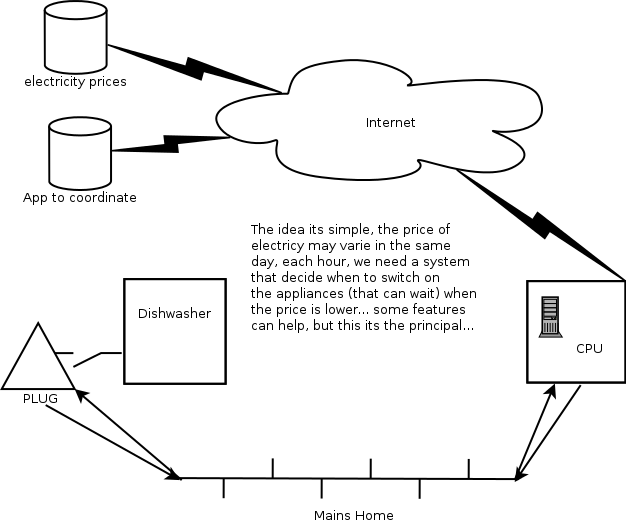Bueno, como era de preveer la conversacion se torna “interesante”… la primera pregunta para ti, y todos los que anden leyendo este hilo es:
1º ¿cual es la manera mas barata de comunicar informacion entre 2 puntos, con el requisito de que los datos son pocos y tienes encufes cerca?
¿PLC con X10 por ejemplo o radiofrecuencia 433Mhz?
2º Si, soy de españa y no se si sucedera igual en algun otro pais, ¿alguien puede decirnos?, pero la idea es poder usar ciertos aparatos cuando el precio de la electricidad sea barato: dependiendo del dia… pudede variar 0.05 euros el kw/h, por tanto, en 1 año… rondaria los 15 euros de ahorro… ideal por ejemplo para
el lavavajillas… y si juntamos el enchufe cliente (conectado al servidor inteligente) con una bateria lo mismo tambien podemos usarlo con el frigorifico.
La idea es ganar la batalla a las electricas… tu placa es bastante interesante… y voy a evaluarla (solo tengo arduinos mas antiguos… y no tengo los modulos de radiofrecuencia) pero si les he echado un vistazo a los enchufes de radiofrecuencia del leroy merlin. Uno de 3000w vale 20 euros, mas tu placa y un arduino rondara los 50 euros, mas los modulos de radio frecuencia por 5 euros… tendriamos un sistema con 2 enchufes por unos 100 euros…
Si necesitas ayuda para el desarrollo de la nueva feature (especialmente en la parte web), o sugerencias para su implementacion, me ofrezco como voluntario para ayudar.
3º ¿Por ultimo, son mas fiables las transmisiones por radiofrecuencia o por X10?
Semi-atuomatic translate:
Well, as I was to foresee the conversation becomes “interesting”… the first question for you, and all who walk by reading this thread is:
1º what is the cheapest way to communicate information between 2 points, with the requirement that the data are few and plugs near you?
X10 PLC ? Eg 433Mhz or radio ?
2º Yes, I am from Spain and if you happen not just in some other country, can anyone tell me, but the idea is to use certain appliances when the electricity price is cheap: depending on the day… its vary 0.05 euros kw/h, therefore at 1 year would be around 15 euros saving… Ideal for example for the dishwasher… and if we put the client plug (connected to the smart server) with a battery, also we can use the fridge.
The idea is to win the battle to the electrical company… your board is quite interesting… and I’ll evaluate (I only have Arduinos oldest… and I have no RF modules) but if you 've missed out the radiofrequency plugs leroy merlin . One 3000w worth 20 euros, but your arduino board and hanging about 50 euros , but the radio frequency module for 5 euros … we would have a system with 2 outlets for about 100 euros …
If you need help for the development of the new feature (special in web part), or suggestions for its implementation, I volunteer to help.
Why 3rd last, are more reliable radio transmissions or X10?




